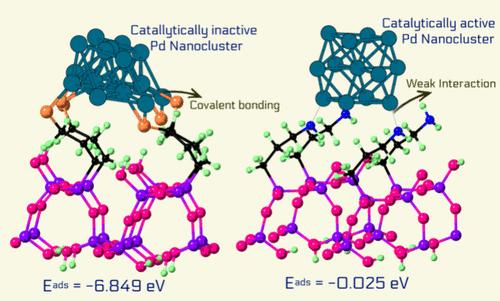当前位置:
X-MOL 学术
›
ACS Appl. Mater. Interfaces
›
论文详情
Our official English website, www.x-mol.net, welcomes your
feedback! (Note: you will need to create a separate account there.)
Catalytic Synergy between Pd Nanoclusters and Ligand-Functionalized Layered Silicates for Improved Formic Acid Dehydrogenation
ACS Applied Materials & Interfaces ( IF 8.3 ) Pub Date : 2024-11-18 , DOI: 10.1021/acsami.4c13770 Esmail Doustkhah, Muhammed Yusufoğlu, Hamza El-Hosainy, Hamaneh Zarenezhad, Yusuke Ide, José Julio Gutiérrez Moreno, M. Hussein N. Assadi
ACS Applied Materials & Interfaces ( IF 8.3 ) Pub Date : 2024-11-18 , DOI: 10.1021/acsami.4c13770 Esmail Doustkhah, Muhammed Yusufoğlu, Hamza El-Hosainy, Hamaneh Zarenezhad, Yusuke Ide, José Julio Gutiérrez Moreno, M. Hussein N. Assadi

|
The synthesis and stabilization of Pd nanoclusters on a support, as well as simultaneously achieving optimal catalytic activity, remain challenging tasks. Functionalizing the support surface with specific ligands offers a promising solution, but it often requires carefully balancing trade-offs between the reaction yield and catalyst stability. Here, we used two different ligands (propylamine and propylthiol) to functionalize the layered silicate’s interlayer surface for Pd nanocluster synthesis and stabilization. For dehydrogenating formic acid, Pd nanoclusters on aminopropyl groups achieved a catalytic activity ∼27-fold higher than that of thiopropyl groups at 70 °C. Our density functional calculations compared the adsorption energetics and bonding characteristics of single Pd atoms and Pd13 nanoclusters on amino- and thio-functionalized silicate surfaces. Pd–N bonds were predicted to be weaker with minimal covalency, while Pd–S bonds exhibit greater covalency due to higher 4d–3p hybridization, resulting in better stability. However, Pd13 clusters undergo severe structural deformation on thiol-functionalized surfaces, resulting in a smaller overall surface area and diminished catalytic stability.
中文翻译:

Pd 纳米团簇和配体功能化层状硅酸盐之间的催化协同作用用于改进甲酸脱氢
在载体上合成和稳定 Pd 纳米团簇,以及同时实现最佳催化活性,仍然是具有挑战性的任务。用特定配体对支持表面进行功能化提供了一种很有前途的解决方案,但它通常需要仔细平衡反应产率和催化剂稳定性之间的权衡。在这里,我们使用了两种不同的配体(丙胺和丙硫醇)来官能化层状硅酸盐的层间表面,以实现 Pd 纳米团簇的合成和稳定。对于甲酸的脱氢,氨丙基上的 Pd 纳米团簇在 70 °C 时达到的催化活性比硫代丙基高 ∼27 倍。 我们的密度泛函计算比较了氨基和硫代官能化硅酸盐表面上单个 Pd 原子和 Pd13 纳米团簇的吸附能量和键合特性。预测 Pd-N 键较弱,共价最小,而 Pd-S 键由于较高的 4d-3p 杂交而表现出更高的共价,从而获得更好的稳定性。然而,Pd13 团簇在巯基官能化表面上发生严重的结构变形,导致总表面积变小和催化稳定性降低。
更新日期:2024-11-19
中文翻译:

Pd 纳米团簇和配体功能化层状硅酸盐之间的催化协同作用用于改进甲酸脱氢
在载体上合成和稳定 Pd 纳米团簇,以及同时实现最佳催化活性,仍然是具有挑战性的任务。用特定配体对支持表面进行功能化提供了一种很有前途的解决方案,但它通常需要仔细平衡反应产率和催化剂稳定性之间的权衡。在这里,我们使用了两种不同的配体(丙胺和丙硫醇)来官能化层状硅酸盐的层间表面,以实现 Pd 纳米团簇的合成和稳定。对于甲酸的脱氢,氨丙基上的 Pd 纳米团簇在 70 °C 时达到的催化活性比硫代丙基高 ∼27 倍。 我们的密度泛函计算比较了氨基和硫代官能化硅酸盐表面上单个 Pd 原子和 Pd13 纳米团簇的吸附能量和键合特性。预测 Pd-N 键较弱,共价最小,而 Pd-S 键由于较高的 4d-3p 杂交而表现出更高的共价,从而获得更好的稳定性。然而,Pd13 团簇在巯基官能化表面上发生严重的结构变形,导致总表面积变小和催化稳定性降低。


















































 京公网安备 11010802027423号
京公网安备 11010802027423号